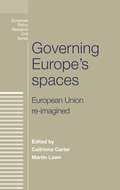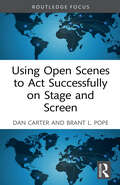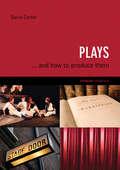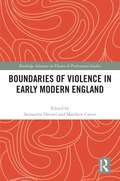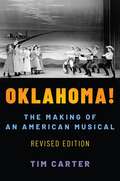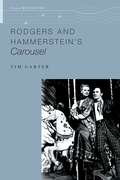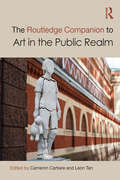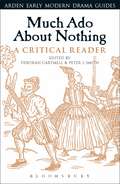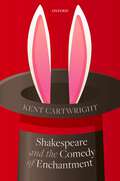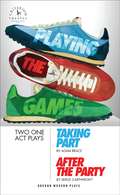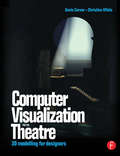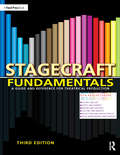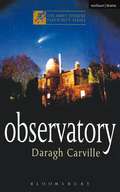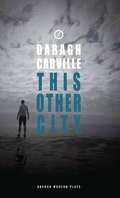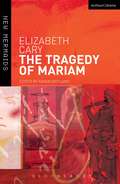- Table View
- List View
Governing Europe's spaces: European Union re-imagined (European Politics)
by Caitriona Carter Martin LawnWhat do we imagine when we imagine Europe and the European Union? To what extent is our understanding of the EU – of its development, its policies and its working processes – shaped by unacknowledged assumptions about what Europe really is? The book constructs a case for re-imagining Europe – not as an entity in Brussels or a series of fixed relations - but as a simultaneously real and imagined space of action which exists to the extent that Europeans and others act in and on it. This Europe is constantly being made in particular spaces, through specific actor struggles, whose interconnections are often ill-defined. We ask how do those concerned with building Europe, with extending and elaborating the EU, think of where they are and what they are doing? The book captures Europeans in the process of making Europe: of performing, interpreting, modelling, referencing, consulting, measuring and de-politicising Europe.
Using Open Scenes to Act Successfully on Stage and Screen
by Dan Carter Brant L. PopeUsing Open Scenes as a "way in" to scripted material, this book establishes a foundational actor training methodology that can be applied to the performance of film or television acting, commercials, and theatrical realism. Unlike other methodologies, this unique approach is devoid of casting considerations or imposed identity, providing actors opportunities that do not rely on nor are restricted by age, gender, race, ethnicity, regional accent, body type, identity, or other defining or delimiting aspects that come into play during the casting process. This allows the actor to focus on personal authenticity as they develop their skills. This book will appeal to undergraduate students, acting teachers, and the contemporary actor seeking a career in film, television, or other electronic media. Visit the companion website www.usingopenscenestoactsuccessful.godaddysites.com for additional Open Scenes and more.
Using Open Scenes to Act Successfully on Stage and Screen
by Dan Carter Brant L. PopeUsing Open Scenes as a "way in" to scripted material, this book establishes a foundational actor training methodology that can be applied to the performance of film or television acting, commercials, and theatrical realism. Unlike other methodologies, this unique approach is devoid of casting considerations or imposed identity, providing actors opportunities that do not rely on nor are restricted by age, gender, race, ethnicity, regional accent, body type, identity, or other defining or delimiting aspects that come into play during the casting process. This allows the actor to focus on personal authenticity as they develop their skills. This book will appeal to undergraduate students, acting teachers, and the contemporary actor seeking a career in film, television, or other electronic media. Visit the companion website www.usingopenscenestoactsuccessful.godaddysites.com for additional Open Scenes and more.
Plays: ...and How To Produce Them (Teach Yourself Ser.)
by David CarterPlays...And How to Produce Them provides a basic introduction for all individuals and groups wishing to undertake the production of a play. It is aimed at the amateur enthusiast and anyone intending to pursue their interest further and undertake professional training. The author, who has over 30 years of experience in drama, takes the reader through the production of a play step by step, from setting up a drama group to the first night and entire run. The book can be read straight through or consulted as a handy reference work. Includes sections on starting a drama group, financing, organising and attracting members; choosing a director, choosing plays, auditions and casting; stage management, lighting, sound, costume, props, and prompting; music and choreography; choosing a venue, and designing and building sets; rehearsing and rehearsal schedules; actors' games and exercises, and make-up; publicity and media coverage; technical rehearsals, dress rehearsals, first nights, last nights, get-ins and get-outs. Additional sections deal with special concerns and interests: producing plays in the open air; schools productions; producing plays with non-English speakers; expatriate productions; plays without scripts; producing Shakespeare and Brecht. The resources section includes plentiful information about helpful drama organisations
Boundaries of Violence in Early Modern England (Routledge Advances in Theatre & Performance Studies)
by Matthew Carter Samantha DresselThis book explores the possibilities and limitations of violence on the Early Modern stage and in the Early Modern world. This collection is divided into three sections: History-cal Violence, (Un)Comic Violence, and Revenge Violence. This division allows scholars to easily find intertextual materials; comic violence may function similarly across multiple comedies but is vastly different from most tragic violence. While the source texts move beyond Shakespeare, this book follows the classic division of Shakespeare’s plays into history, comedy, and tragedy. Each section of the book contains one chapter engaging with modern dramatic practice along with several that take textual or historical approaches. This wide-ranging approach means that the book will be appropriate both for specialists in Early Modern violence who are looking across multiple perspectives, and for students or scholars researching texts or approaches.
Oklahoma!: The Making of an American Musical, Revised and Expanded Edition (Broadway Legacies)
by Tim CarterFirst published in 2007, "Oklahoma!": The Making of an American Musical tells the full story of the beloved Rodgers and Hammerstein musical. Author Tim Carter examines archival materials, manuscripts, and journalism, and the lofty aspirations and mythmaking that surrounded the musical from its very inception. The book made for a watershed moment in the study of the American musical: the first well-researched, serious musical analysis of this landmark show by a musicologist, it was also one of the first biographies of a musical, transforming a field that had previously tended to orient itself around creators rather than creations. In this new and fully revised edition, Carter draws further on recently released sources, including the Rouben Mamoulian Papers at the Library of Congress, with additional correspondence, contracts, and even new versions of the working script used - and annotated - throughout the show's rehearsal process. Carter also focuses on the key players and concepts behind the musical, including the original play on which it was based (Lynn Riggs's Green Grow the Lilacs) and the Theatre Guild's Theresa Helburn and Lawrence Langner, who fatefully brought Rodgers and Hammerstein together for their first collaboration. The crucial new perspectives these revisions and additions provide make this edition of Carter's seminal work a compulsory purchase for all teachers, students, and lovers of musical theater.
OKLAHOMA! 2E BWL C: The Making of an American Musical, Revised and Expanded Edition (Broadway Legacies)
by Tim CarterFirst published in 2007, "Oklahoma!": The Making of an American Musical tells the full story of the beloved Rodgers and Hammerstein musical. Author Tim Carter examines archival materials, manuscripts, and journalism, and the lofty aspirations and mythmaking that surrounded the musical from its very inception. The book made for a watershed moment in the study of the American musical: the first well-researched, serious musical analysis of this landmark show by a musicologist, it was also one of the first biographies of a musical, transforming a field that had previously tended to orient itself around creators rather than creations. In this new and fully revised edition, Carter draws further on recently released sources, including the Rouben Mamoulian Papers at the Library of Congress, with additional correspondence, contracts, and even new versions of the working script used - and annotated - throughout the show's rehearsal process. Carter also focuses on the key players and concepts behind the musical, including the original play on which it was based (Lynn Riggs's Green Grow the Lilacs) and the Theatre Guild's Theresa Helburn and Lawrence Langner, who fatefully brought Rodgers and Hammerstein together for their first collaboration. The crucial new perspectives these revisions and additions provide make this edition of Carter's seminal work a compulsory purchase for all teachers, students, and lovers of musical theater.
Rodgers and Hammerstein's Carousel (Oxford Keynotes)
by Tim CarterCarousel (1945), with music by Richard Rodgers and the book and lyrics by Oscar Hammerstein II, was their second collaboration following the surprising success of Oklahoma! (1943). They worked again with Theresa Helburn and Lawrence Langner of the Theatre Guild (producers), Rouben Mamoulian (director), and Agnes de Mille (choreographer). But with Oklahoma! still running to sell-out houses, they needed to do something quite different. Based on a play, Liliom (1909), by the Hungarian playwright Ferenc Molnár, Carousel took Broadway musical theater in far darker directions because of its subject matter-the protagonist, Billy Bigelow, is wholly an anti-hero-and also given its extensive music that some claimed came close to opera. The action is shifted from a gritty working-class suburb of Budapest to the New England coast (Maine), but the themes remain the same as two social misfits try to survive harsh economic times. Billy Bigelow is unemployed, prone to domestic violence, and dies in the course of committing a robbery; Julie Jordan sticks by him through thick and thin; and the show seeks some manner of redemption for both of them as Billy is given a day back on earth to do some good for his wife and their daughter. Troubling though these matters are nowadays, they fit squarely in the context of a country moving through the end of World War II to an uncertain future. Not for nothing had composers such as Giacomo Puccini and Kurt Weill already tried to persuade Molnár to release his play. It also led Rodgers and Hammerstein to new heights: songs such as "If I Loved You," Billy's "Soliloquy," and "You'll Never Walk Alone" transformed the American musical. In this book, we discover how and why they came about, and exactly what Carousel was trying to achieve.
RODGERS & HAMMERSTEIN'S CAROUSEL OKS C (Oxford Keynotes)
by Tim CarterCarousel (1945), with music by Richard Rodgers and the book and lyrics by Oscar Hammerstein II, was their second collaboration following the surprising success of Oklahoma! (1943). They worked again with Theresa Helburn and Lawrence Langner of the Theatre Guild (producers), Rouben Mamoulian (director), and Agnes de Mille (choreographer). But with Oklahoma! still running to sell-out houses, they needed to do something quite different. Based on a play, Liliom (1909), by the Hungarian playwright Ferenc Molnár, Carousel took Broadway musical theater in far darker directions because of its subject matter-the protagonist, Billy Bigelow, is wholly an anti-hero-and also given its extensive music that some claimed came close to opera. The action is shifted from a gritty working-class suburb of Budapest to the New England coast (Maine), but the themes remain the same as two social misfits try to survive harsh economic times. Billy Bigelow is unemployed, prone to domestic violence, and dies in the course of committing a robbery; Julie Jordan sticks by him through thick and thin; and the show seeks some manner of redemption for both of them as Billy is given a day back on earth to do some good for his wife and their daughter. Troubling though these matters are nowadays, they fit squarely in the context of a country moving through the end of World War II to an uncertain future. Not for nothing had composers such as Giacomo Puccini and Kurt Weill already tried to persuade Molnár to release his play. It also led Rodgers and Hammerstein to new heights: songs such as "If I Loved You," Billy's "Soliloquy," and "You'll Never Walk Alone" transformed the American musical. In this book, we discover how and why they came about, and exactly what Carousel was trying to achieve.
The Routledge Companion to Art in the Public Realm (Routledge Art History and Visual Studies Companions)
by Cameron CartiereThis multidisciplinary companion offers a comprehensive overview of the global arena of public art.It is organised around four distinct topics: activation, social justice, memory and identity, and ecology, with a final chapter mapping significant works of public and social practice art around the world between 2008 and 2018. The thematic approach brings into view similarities and differences in the recent globalisation of public art practices, while the multidisciplinary emphasis allows for a consideration of the complex outcomes and consequences of such practices, as they engage different disciplines and communities and affect a diversity of audiences beyond the existing 'art world'. The book will highlight an international selection of artist projects that illustrate the themes.This book will be of interest to scholars in contemporary art, art history, urban studies, and museum studies.
The Routledge Companion to Art in the Public Realm (Routledge Art History and Visual Studies Companions)
by Cameron Cartiere Leon TanThis multidisciplinary companion offers a comprehensive overview of the global arena of public art.It is organised around four distinct topics: activation, social justice, memory and identity, and ecology, with a final chapter mapping significant works of public and social practice art around the world between 2008 and 2018. The thematic approach brings into view similarities and differences in the recent globalisation of public art practices, while the multidisciplinary emphasis allows for a consideration of the complex outcomes and consequences of such practices, as they engage different disciplines and communities and affect a diversity of audiences beyond the existing 'art world'. The book will highlight an international selection of artist projects that illustrate the themes.This book will be of interest to scholars in contemporary art, art history, urban studies, and museum studies.
Much Ado About Nothing: A Critical Reader (Arden Early Modern Drama Guides)
by Deborah Cartmell Peter J. SmithThis volume offers an accessible and thought-provoking guide to this major Shakespearean comedy, surveying its key themes and evolving critical preoccupations. It also provides a detailed and up-to-date history of the play's rich stage and screen performance, looking closely at major contemporary performances, including Josie Rourke's film starring David Tennant and Catherine Tate, Vanessa Redgrave and James Earl Jones at the Old Vic, and the RSC's recent rebranding of it as a sequel. Moving through to four new critical essays, the guide opens up fresh perspectives, including contemporary directors' deployment of older actors within the lead roles, the play's relationship to Love's Labour's Lost, its presence on Youtube and the ways in which tales and ruses in the play belong to a wider concern with varieties of crime. The volume finishes with a guide to critical, web-based and production-related resources and an annotated bibliography provide a basis for further research.
Much Ado About Nothing: A Critical Reader (Arden Early Modern Drama Guides)
by Deborah Cartmell Peter J. SmithThis volume offers an accessible and thought-provoking guide to this major Shakespearean comedy, surveying its key themes and evolving critical preoccupations. It also provides a detailed and up-to-date history of the play's rich stage and screen performance, looking closely at major contemporary performances, including Josie Rourke's film starring David Tennant and Catherine Tate, Vanessa Redgrave and James Earl Jones at the Old Vic, and the RSC's recent rebranding of it as a sequel. Moving through to four new critical essays, the guide opens up fresh perspectives, including contemporary directors' deployment of older actors within the lead roles, the play's relationship to Love's Labour's Lost, its presence on Youtube and the ways in which tales and ruses in the play belong to a wider concern with varieties of crime. The volume finishes with a guide to critical, web-based and production-related resources and an annotated bibliography provide a basis for further research.
Shakespeare and the Comedy of Enchantment
by Kent CartwrightShakespeare and the Comedy of Enchantment argues that enchantment constitutes a key emotional and intellectual dimension of Shakespeare's comedies. It thus makes a new claim about the rejuvenating value of comedy for individuals and society. Shakespeare's comedies orchestrate ongoing encounters between the rational and the mysterious, between doubt and fascination, with feelings moved by elements of enchantment that also seem a little ridiculous. In such a drama, lines of causality become complex, and even satisfying endings leave certain matters incomplete and contingent—openings for scrutiny and thought. In addressing enchantment, the book takes exception to the modernist vision of a deterministic 'disenchanted' world. As Shakespeare's action advances, comic mysteries accrue—uncanny coincidences; magical sympathies; inexplicable repetitions; psychic influences; and puzzlements about the meaning of events—all of whose numinous effects linger ambiguously after reason has apparently answered the play's questions. Separate chapters explore the devices, tropes, and motifs of enchantment: magical clowns who alter the action through stop-time interludes; structural repetitions that suggest mysteriously converging, even opaquely providential destinies; locales that oppose magical and protean forces to regulatory and quotidian values; desires, thoughts, and utterances that 'manifest' comically monstrous events; characters who return from the dead, facilitated by the desires of the living; play-endings crossed by harmony and dissonance, with moments of wonder that make possible the mysterious action of forgiveness. Wonder and wondering in Shakespeare's and other comedies, it emerges, become the conditions for new possibilities. Chapters refer extensively to early modern history, Renaissance and modern theories of comedy, treatises on magical science, and contemporaneous Italian and Tudor comedy.
Shakespeare and the Comedy of Enchantment
by Kent CartwrightShakespeare and the Comedy of Enchantment argues that enchantment constitutes a key emotional and intellectual dimension of Shakespeare's comedies. It thus makes a new claim about the rejuvenating value of comedy for individuals and society. Shakespeare's comedies orchestrate ongoing encounters between the rational and the mysterious, between doubt and fascination, with feelings moved by elements of enchantment that also seem a little ridiculous. In such a drama, lines of causality become complex, and even satisfying endings leave certain matters incomplete and contingent—openings for scrutiny and thought. In addressing enchantment, the book takes exception to the modernist vision of a deterministic 'disenchanted' world. As Shakespeare's action advances, comic mysteries accrue—uncanny coincidences; magical sympathies; inexplicable repetitions; psychic influences; and puzzlements about the meaning of events—all of whose numinous effects linger ambiguously after reason has apparently answered the play's questions. Separate chapters explore the devices, tropes, and motifs of enchantment: magical clowns who alter the action through stop-time interludes; structural repetitions that suggest mysteriously converging, even opaquely providential destinies; locales that oppose magical and protean forces to regulatory and quotidian values; desires, thoughts, and utterances that 'manifest' comically monstrous events; characters who return from the dead, facilitated by the desires of the living; play-endings crossed by harmony and dissonance, with moments of wonder that make possible the mysterious action of forgiveness. Wonder and wondering in Shakespeare's and other comedies, it emerges, become the conditions for new possibilities. Chapters refer extensively to early modern history, Renaissance and modern theories of comedy, treatises on magical science, and contemporaneous Italian and Tudor comedy.
Playing the Games (Oberon Modern Plays)
by Serge Cartwright Adam BracePlaying the Games is a duo of plays focussing on the London 2012 Olympics, it includes:Taking Part by Adam BraceLucky Henry, a Congolese security guard, has set his sights on representing his country at the 2012 Olympics. Only one problem; he’s a terrible swimmer and his Russian coach wants to fly home on the first day of training. Everyone loves an underdog – think Eddie the Eagle or Eric the Eel. Follow Henry’s journey from deep end straggler to Olympic hopeful as the two men try to fulfil their dreams at the London games.After The Party by Serge CartwrightSean and Ray are best friends from Stratford. Once a promising DJ double act, now they’re stuck in a rut: 30ish, unemployed but still clinging to a fantasy of making it in the music industry. With a baby on the way and the world about to arrive on their doorstep for London 2012, it could be the perfect opportunity for them to make something of their lives...
Computer Visualization for the Theatre: 3D Modelling for Designers
by Gavin Carver Christine WhiteTheatre designers using 3D software for computer visualisation in the theatre will find this book both a guide to the creative design process as well as an introduction to the use of computers in live performance. Covering the main software packages in use: Strata Studio Base, 3D Studio Max and 3D Studio Viz, the book provides techniques for 3D modelling alongside creative ideas and concepts for working in 3D space. Projects are provided to sharpen your awareness and digital skills as well as suggested further reading to broaden the scope of your theatrical and design knowledge. This book is both a useful day to day reference as well as an inspirational starting point for implementing your own ideas. The authors are experienced trainers in the field and understand the pitfalls to be avoided as well as the possibilities to be explored using computer visualisation for designing theatre space. They provide insightful hands on descriptions of techniques used in the development of performance projects set in the wider context of design considerations. The book is highly informative about the technology of computer visualisation providing examples of working practice applicable to all software.
Computer Visualization for the Theatre: 3D Modelling for Designers
by Gavin Carver Christine WhiteTheatre designers using 3D software for computer visualisation in the theatre will find this book both a guide to the creative design process as well as an introduction to the use of computers in live performance. Covering the main software packages in use: Strata Studio Base, 3D Studio Max and 3D Studio Viz, the book provides techniques for 3D modelling alongside creative ideas and concepts for working in 3D space. Projects are provided to sharpen your awareness and digital skills as well as suggested further reading to broaden the scope of your theatrical and design knowledge. This book is both a useful day to day reference as well as an inspirational starting point for implementing your own ideas. The authors are experienced trainers in the field and understand the pitfalls to be avoided as well as the possibilities to be explored using computer visualisation for designing theatre space. They provide insightful hands on descriptions of techniques used in the development of performance projects set in the wider context of design considerations. The book is highly informative about the technology of computer visualisation providing examples of working practice applicable to all software.
Stagecraft Fundamentals: A Guide and Reference for Theatrical Production
by Rita Kogler CarverStagecraft Fundamentals tackles every aspect of basic theatre production with Rita Kogler Carver’s signature wit and engaging voice. The history of stagecraft, safety precautions, lighting, costumes, scenery, career planning tips, and more are discussed, illustrated by beautiful color examples that both display step-by-step procedures and break with the traditionally boring black and white introductory theatre book. This third edition improves upon the last, featuring three new chapters on design for props, projection, and touring. Also included are new end-of-chapter questions and an expanded discussion on LED lighting, stage automation, digital technology, stage management, makeup, theatre management, and sound design. This is the must have introductory theatre production book.
Stagecraft Fundamentals: A Guide and Reference for Theatrical Production
by Rita Kogler CarverStagecraft Fundamentals tackles every aspect of basic theatre production with Rita Kogler Carver’s signature wit and engaging voice. The history of stagecraft, safety precautions, lighting, costumes, scenery, career planning tips, and more are discussed, illustrated by beautiful color examples that both display step-by-step procedures and break with the traditionally boring black and white introductory theatre book. This third edition improves upon the last, featuring three new chapters on design for props, projection, and touring. Also included are new end-of-chapter questions and an expanded discussion on LED lighting, stage automation, digital technology, stage management, makeup, theatre management, and sound design. This is the must have introductory theatre production book.
Observatory (Modern Plays)
by Daragh CarvilleA gothic science-fiction thriller, Observatory details the entangled lives of four people across two centuriesObservatory is set at the Armagh Observatory and Museum for Astronomy and Natural Philosophy, in both 1799 and 1999. Historian Jon McKenna, hired to compile a computerised catalogue of the Observatory archives, finds his life becoming entangled with that of Nicola McLoughlin, assistant astronomer at the Observatory. Together they work to uncover the two-hundred-year-old story of astronomer Archibald Hamilton and his assistant Robert Hogg - man of science, man of God, and revolutionary. The Observatory, a symbol of both science and religion, becomes the setting for a powerful exploration of nationhood and revolution, love and betrayal."The writing is inspired, deceptively subtle behind its up-front bile and cracked humour" (Guardian)
Observatory (Modern Plays)
by Daragh CarvilleA gothic science-fiction thriller, Observatory details the entangled lives of four people across two centuriesObservatory is set at the Armagh Observatory and Museum for Astronomy and Natural Philosophy, in both 1799 and 1999. Historian Jon McKenna, hired to compile a computerised catalogue of the Observatory archives, finds his life becoming entangled with that of Nicola McLoughlin, assistant astronomer at the Observatory. Together they work to uncover the two-hundred-year-old story of astronomer Archibald Hamilton and his assistant Robert Hogg - man of science, man of God, and revolutionary. The Observatory, a symbol of both science and religion, becomes the setting for a powerful exploration of nationhood and revolution, love and betrayal."The writing is inspired, deceptively subtle behind its up-front bile and cracked humour" (Guardian)
This Other City (Oberon Modern Plays)
by Daragh CarvilleIn the newest play from this prolific Northern Irish writer, Carville turns his attention to the demons beneath the shiny surface of the new, metropolitan Belfast. This Other City plays out against a backdrop of coffee shops, beauty salons and overpriced apartments. It’s a Belfast where dodgy deals are done in boutique hotel rooms with a view.
The Tragedy of Mariam (New Mermaids)
by Elizabeth Cary Karen BritlandThe Tragedy of Mariam, the Fair Queen of Jewry is a Jacobean closet drama by Elizabeth Tanfield Cary. First published in 1613, it was the first work by a woman to be published under her real name. Never performed during Cary's lifetime, and apparently never intended for performance, the Senecan revenge tragedy tells the story of Mariam, the second wife of Herod. The play exposes and explores the themes of sex, divorce, betrayal, murder, and Jewish society under Herod's tyrannous rule. The wide-ranging introduction discusses the play in the context of closet drama, female dramatists and feminist criticism, providing an ideal edition for study and teaching. This is a major edition of an unusual and provocative play not widely available elsewhere.
The Tragedy of Mariam: The Fair Queen Of Jewry (New Mermaids)
by Elizabeth Cary Karen BritlandThe Tragedy of Mariam, the Fair Queen of Jewry is a Jacobean closet drama by Elizabeth Tanfield Cary. First published in 1613, it was the first work by a woman to be published under her real name. Never performed during Cary's lifetime, and apparently never intended for performance, the Senecan revenge tragedy tells the story of Mariam, the second wife of Herod. The play exposes and explores the themes of sex, divorce, betrayal, murder, and Jewish society under Herod's tyrannous rule. The wide-ranging introduction discusses the play in the context of closet drama, female dramatists and feminist criticism, providing an ideal edition for study and teaching. This is a major edition of an unusual and provocative play not widely available elsewhere.
